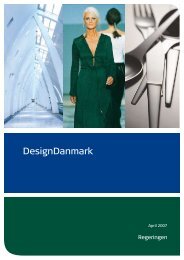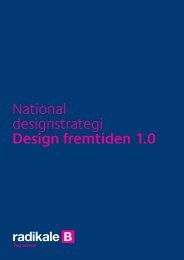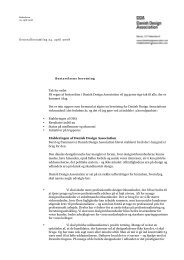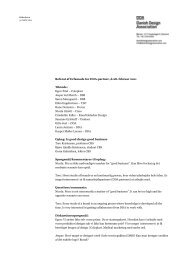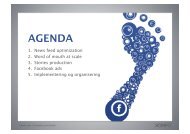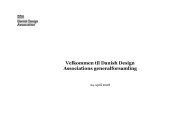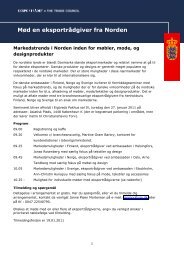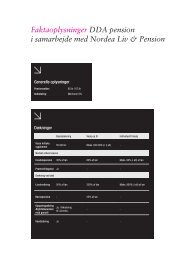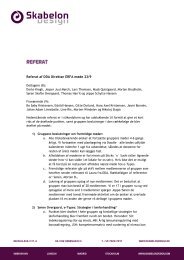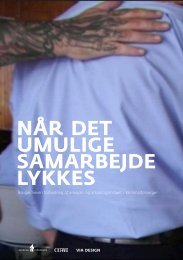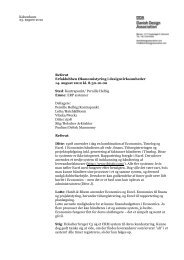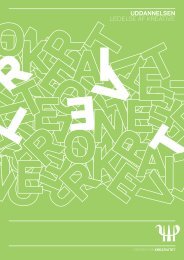Teddy bag - INDEX: Design to Improve Life
Teddy bag - INDEX: Design to Improve Life
Teddy bag - INDEX: Design to Improve Life
You also want an ePaper? Increase the reach of your titles
YUMPU automatically turns print PDFs into web optimized ePapers that Google loves.
<strong>Teddy</strong> <strong>bag</strong><br />
François Verez<br />
Ane Eguiguren
0.<br />
<strong>INDEX</strong><br />
A project for:<br />
<strong>INDEX</strong>:DESIGN<br />
CHALLENGE<br />
11/2010<br />
1. INTRODUCTION<br />
2. WHAT IS TEDDY BAG<br />
3. TEDDY’S LIFE<br />
3.1. Raw Materials<br />
3.2. Production process<br />
3.3. Use<br />
4. WHAT DOES TEDDY BAG BRING<br />
TO DEVELOPING COUNTRIES<br />
05<br />
07<br />
08<br />
08<br />
11<br />
18<br />
23
1.<br />
INTRO-<br />
DUCTION<br />
WHY DO WE PARTICIPATE IN <strong>INDEX</strong>: DESIGN CHALLENGE.<br />
We found that the contest was an opportunity <strong>to</strong> think<br />
about a product whose purpose was not intended for<br />
financial gain. It was also an opportunity <strong>to</strong> create affordable<br />
and socially responsible objects for the developing<br />
countries, especially <strong>to</strong> improve education. In our opinion,<br />
education is the basis for the develpment of a country.<br />
The principal purpose was <strong>to</strong> use design <strong>to</strong> help and create<br />
useful products.<br />
WHY DID WE CHOOSE THE OPEN CHALLENGE.<br />
We wanted <strong>to</strong> make something moral and emotionally<br />
rewarding, instead of something technical. We started<br />
thinking about why children want <strong>to</strong> go <strong>to</strong> school and how<br />
do they take pleasure in it. We decided <strong>to</strong> create an useful<br />
object that at the same time would have an emotional<br />
bond with the child.<br />
We all know how much children like school equipment;<br />
the new pencil for the back <strong>to</strong> school, the old school <strong>bag</strong><br />
they get attached <strong>to</strong>... The kid’s studying equipment is as<br />
important as the place where he studies.<br />
So our aim was <strong>to</strong> create an “emotionally living” object<br />
that motivate children <strong>to</strong> study at school and at home.<br />
We have created an object that allows the kid work anywhere<br />
and that is his education partner.
2.<br />
WHAT IS<br />
TEDDY BAG<br />
TEDDY BAG IS A CONCEPT OF SCHOOL FURNITURE/<br />
EQUIPMENT FOR DEVELOPING COUNTRIES<br />
It is an school <strong>bag</strong> that<br />
turns in<strong>to</strong> a desk.<br />
Allows children carry<br />
all what they need <strong>to</strong><br />
study; in school, at<br />
home or anywhere.<br />
<strong>Teddy</strong> <strong>bag</strong><br />
It is made by cardboard<br />
so it is light.<br />
Its simple production<br />
process makes<br />
possible <strong>to</strong> produce<br />
it easily in developing<br />
countries.
3.<br />
TEDDY’S<br />
LIFE<br />
1. RAW MATERIALS<br />
Everything is recovered:<br />
WHERE DO THESE MATERIALS COME FROM<br />
TYPOLOGIES OF MUNICIPAL WASTE COLLECTION AND<br />
TREATMENT BY COUNTRY INCOME<br />
The attitude <strong>to</strong> waste and<br />
waste treatments varies significantly<br />
between countries<br />
and depends on their his<strong>to</strong>ry,<br />
their culture and their<br />
geography.<br />
An abstract of 2006 World Waste Survey<br />
Veolia environmental service.<br />
For the moment in developing countries there is less waste<br />
than in the developed ones, but it is estimated that the<br />
quantity of waste will increase with their development. This<br />
way, products like <strong>Teddy</strong> <strong>bag</strong> can be a way <strong>to</strong> educate them<br />
in reusing waste. As we can see in the second diagram, even<br />
the developed countries are not used <strong>to</strong> reuse waste. And<br />
the most used treatment is always the controlled landfill or<br />
incineration for the asiatic developed countries.<br />
MUNICIPAL WASTE TREATMENT BREAKDOWN IN<br />
A SELECTED NUMBER OF COUNTRIES (AS %)<br />
Both diagrams extracted from:<br />
An abstract of 2006 World<br />
Waste Survey<br />
Veolia environmental service.<br />
Cardboard boxes<br />
Plastic <strong>bag</strong>s
In the past, humans regarded their<br />
resources as rare, knowing that<br />
their demands outweighed supply.<br />
Everything available had <strong>to</strong> be<br />
used and almost nothing went <strong>to</strong><br />
waste. Due <strong>to</strong> limited techniques,<br />
natural resources remained largely<br />
unexploited and all types of<br />
waste had <strong>to</strong> be recycled.<br />
An abstract of 2006 World Waste Survey<br />
Veolia environmental service<br />
2. PRODUCTION PROCESS<br />
FOR THE BAG:<br />
1<br />
3<br />
Recover cardboard boxes<br />
(corrugated, 5mm of thickness)<br />
2<br />
4<br />
Draw the plan on the cardboard<br />
Cut, fold and glue* the cardboard<br />
* we can glue with white glue or with a mixture of<br />
starch and therebentine alcohol (more ecological)<br />
Put craft paper tape in every corner<br />
in order <strong>to</strong> fill in all the gaps<br />
9x<br />
5 6<br />
3x<br />
Marl<br />
a mix of calcium<br />
carbonate and clay<br />
Water<br />
6x<br />
1x<br />
White<br />
glue<br />
Linen oil<br />
Apply a mixture* that will then allow painting<br />
* we can also use starch and therebentine<br />
alcohol <strong>to</strong> create the mixture (more ecological)<br />
7 8<br />
Apply acrylic paint*<br />
* we can also use pota<strong>to</strong>es and<br />
pigments <strong>to</strong> create the paint<br />
VARNISH<br />
Apply varnish*<br />
* we can also use shellac and alcohol<br />
<strong>to</strong> create the varnish (more ecological)<br />
RESULT:<br />
A COLORED AND WATER<br />
RESISTANT* CARDBOARD OBJECT<br />
* can resist <strong>to</strong> the rain and exterior humidity
FOR THE BAG:<br />
The <strong>bag</strong> has three parts<br />
PART 2: STOOL<br />
11<br />
3<br />
24<br />
PART 1: SCHOOL BAG<br />
7<br />
27 5<br />
7<br />
11<br />
15<br />
20<br />
36,5<br />
15<br />
20<br />
27 13 13 27 13 13 27<br />
Scale 1:10<br />
10<br />
10<br />
How <strong>to</strong> build it:<br />
18<br />
12<br />
18<br />
This is the original<br />
drawing and it could be<br />
built from one or several<br />
cardboard sheets<br />
5<br />
27<br />
Scale 1:10<br />
How <strong>to</strong> build it:<br />
PART 3: TABLE<br />
How <strong>to</strong> build it:<br />
1<br />
2,5<br />
velcro clasp<br />
2<br />
15<br />
water bottle <strong>to</strong>ps<br />
as protec<strong>to</strong>rs<br />
36 27<br />
x2<br />
31<br />
7<br />
26<br />
21<br />
Scale 1:10
The chair<br />
With its accordion shape it can easily<br />
resist up <strong>to</strong> 60kg.<br />
The table<br />
The cardboard sheet which allows <strong>to</strong> build the<br />
table permits <strong>to</strong> carry and protect some paper<br />
sheets. This table includes also a little space <strong>to</strong><br />
keep some pencils stable.<br />
The school <strong>bag</strong><br />
It has space <strong>to</strong> carry the table and some school<br />
material; as a ring binder, with some books.
FOR THE HANDLES:<br />
1<br />
2<br />
Recover plastic <strong>bag</strong>s<br />
(a plastic <strong>bag</strong> is enough for two handles,<br />
one meter each)<br />
Cut the plastic <strong>bag</strong>s creating<br />
a long thread<br />
3<br />
4<br />
RESULT:<br />
VERY RESISTANT AND<br />
SUSTAINABLE WAY TO REUSE<br />
PLASTIC BAGS, WHICH POLLUTE<br />
THE LANDSCAPE<br />
Knit the plastic thread creating a mesh
3. USE<br />
THE SCHOOL BAG ALLOWS CARRYING<br />
UP TO 10KG OF WEIGHT<br />
THE SCHOOL DESK ENCOURAGES SHARING
Colorama
3.<br />
WHAT DOES TEDDY<br />
BAG BRING TO<br />
DEVELOPING<br />
COUNTRIES<br />
AND YOU CAN ALSO MAKE<br />
YOUR OWN DESIGN!<br />
<strong>Teddy</strong> Bag can be easily produced in the country without any<br />
complicated <strong>to</strong>ols or machines.<br />
This fact creates work that can be executed by anybody,<br />
without needing any specific formation.<br />
This type of products help creating small business and participate<br />
in the development of the community. The sustainable aspect of<br />
<strong>Teddy</strong> Bag (no costs in raw material and very simple production<br />
process) makes it a very accesible product.<br />
Moreover, its easy production makes possible <strong>to</strong> adapt its dimensions<br />
<strong>to</strong> different ages.<br />
<strong>Teddy</strong> Bag carries the idea of making a large collection of cardboard<br />
made school equipment.<br />
MArie<br />
Marie’s example
Yes we <strong>bag</strong>!



